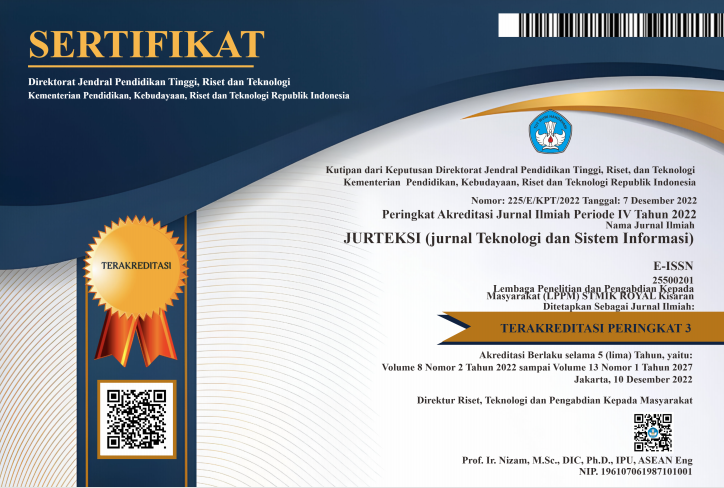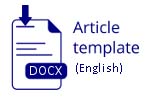SELECTION OF THE BEST COFFEE SHOP USING THE VIKOR METHOD
Abstract
Coffee businesses in Medan are becoming increasingly competitive. Due to the invention of coffee menus and coffee serving packaging to remain competitive, every coffee shop has a distinct quality. However, choosing the finest coffee shop remains a challenge for the decision-maker in this scenario, the consumer. Therefore, we need a mechanism to pick which clients or visits to a coffee shop. Clear, simple-to-understand idea-winning tactics make it simple to make decisions that are effective. The efficacy of various choices may be assessed by an efficient computer procedure. The purpose of this study is to use the Visekriterijumsko Kompromisno Rangiranje (Vikor) technique to choose the best coffee shop based on the following criteria: ambience, taste, pricing, diversity of the menu, service, and facilities. The responses of the questionnaire are used to determine the weight gain based on weighing. The option with the lowest value is chosen as the best option when A5 = 0. In other words, alternative A5 was chosen as the spot where coffee is most strongly recommendedReferences
M. del R. Pérez-Salazar, A. A. Aguilar-Lasserre, M. G. Cedillo-Campo, R. Posada-Gómez, M. J. del Moral-Argumedo, and J. C. Hernández-González, “An agent-based model driven decision support system for reactive aggregate production scheduling in the Green Coffee Supply Chain,†Appl. Sci., vol. 9, no. 22, 2019, doi: 10.3390/app9224903.
P. T. Prasetyaningrum, “Enhancing Sales Determination for Coffee Shop Packages through Associated Data Mining : Leveraging the FP- Growth Algorithm,†J. Inf. Syst. Informatics, vol. 5, no. 2, pp. 758–770, 2023, doi: 10.51519/journalisi.v5i2.500.
N. Hasti and R. Fitriyandi, “The Decision Support System in Selecting The Characteristics of Coffee By Using Analytic Hierarcy Process Method,†IJNMT (International J. New Media Technol., vol. 6, no. 2, pp. 60–63, 2020, doi: 10.31937/ijnmt.v6i2.1450.
A. Fauzi, N. Indriyani, and A. Bayu Hasta Yanto, “Selection of Coffee Shop Business Locations Using the Analytical Hierarchy Process Method,†J. Teknol. Dan Open Source, vol. 4, no. 2, pp. 133–140, 2021, doi: 10.36378/jtos.v4i2.1771.
P. Bhanwar, A. S. Reddy, and T. N. Dave, “A spreadsheet-based decision support system for selection of optimal soil liquefaction mitigation technique,†Decis. Anal. J., vol. 6, no. December 2022, p. 100154, 2023, doi: 10.1016/j.dajour.2022.100154.
J. Hutagalung, “Application of the AHP-TOPSIS Method to Determine the Feasibility of Fund Loans Penerapan Metode AHP TOPSIS untuk Menentukan Kelayakan Pinjaman Dana,†J. Pekommas, vol. 6, no. 1, pp. 1–11, 2021, doi: 10.30818/jpkm.2021.2060101.
W. M. Sari et al., “Improving the Quality of Management with the Concept of Decision Support Systems in Determining Factors for Choosing a Cafe based on Consumers,†J. Phys. Conf. Ser., vol. 1471, no. 1, 2020, doi: 10.1088/1742-6596/1471/1/012009.
A. Tohir et al., “Decision Support System using WP Algorithm for Teacher Selection,†J. Phys. Conf. Ser., vol. 1845, no. 1, pp. 1–8, 2021, doi: 10.1088/1742-6596/1845/1/012028.
F. Effendy, “Mobile based decision support system of supplier evaluation,†Int. J. Interact. Mob. Technol., vol. 14, no. 4, pp. 61–73, 2020, doi: 10.3991/IJIM.V14I04.11371.
A. Shekhovtsov and W. Salabun,“A comparative case study of the VIKOR and TOPSIS rankings similarity,†Procedia Comput. Sci., vol. 176, no. 24, pp. 3730–3740, 2020, doi: 10.1016/j.procs.2020.09.014.
A. N. Vardin, R. Ansari, M. Khalilzadeh, J. Antucheviciene, and R. Bausys, “An integrated decision support model based on bwm and fuzzy-vikor techniques for contractor selection in construction projects,†Sustain., vol. 13, no. 12, 2021, doi: 10.3390/su13126933.
P. Babashamsi, A. Golzadfar, N. I. M. Yusoff, H. Ceylan, and N. G. M. Nor, “Integrated fuzzy analytic hierarchy process and VIKOR method in the prioritization of pavement maintenance activities,†Int. J. Pavement Res. Technol., vol. 9, no. 2, pp. 112–120, 2016, doi: 10.1016/j.ijprt.2016.03.002.
H. Razzaque, S. Ashraf, W. Kallel, M. Naeem, and M. Sohail, “A strategy for hepatitis diagnosis by using spherical q-linear Diophantine fuzzy Dombi aggregation information and the VIKOR method,†AIMS Math., vol. 8, no. 6, pp. 14362–14398, 2023, doi: 10.3934/math.2023735.
Z. R. Tamin, K. Yulianto, and ..., “Analisis Pemilihan Coffee Shop Menggunakan Metode Analytical Hierarchy Process (AHP),†JISIP (Jurnal Ilmu …, vol. 6, no. 4, pp. 2258–2264, 2022, doi: 10.36312/jisip.v6i4.3660/http.
M. A. Abdullah and R. T. Aldisa, “Penerapan Metode MABAC pada Penentuan Coffee Shop Terbaik,†J. Ris. Komputer), vol. 10, no. 1, pp. 338–347, 2023, doi: 10.30865/jurikom.v10i1.5820.
Y. J. B. Parrangan et al., “The implementation of VIKOR method to improve the effectiveness of Sidi learning graduation,†Int. J. Eng. Technol., vol. 7, no. 3.4 Special Issue 4, pp. 264–267, 2018, doi: 10.14419/ijet.v7i3.4.19854.
D. Siregar et al., “Multi-Attribute Decision Making with VIKOR Method for Any Purpose Decision,†J. Phys. Conf. Ser., vol. 1019, no. 1, pp. 1–6, 2018, doi: 10.1088/1742-6596/1019/1/012034.
B. Kizielewicz and A. Baczkiewicz, “Comparison of Fuzzy TOPSIS, Fuzzy VIKOR, Fuzzy WASPAS and Fuzzy MMOORA methods in the housing selection problem,†Procedia Comput. Sci., vol. 192, no. 25, pp. 4578–4591, 2021, doi: 10.1016/j.procs.2021.09.236.
I. Belošević, M. Kosijer, M. Ivić, and N. Pavlović, “Group decision making process for early stage evaluations of infrastructure projects using extended VIKOR method under fuzzy environment,†Eur. Transp. Res. Rev., vol. 10, no. 2, 2018, doi: 10.1186/s12544-018-0318-4.
M. Haji, M. R. Kamankesh, M. Jamshidi, M. Daghineh, and A. A. Shaltooki, “A multi-criteria ranking algorithm based on the VIKOR method for meta-search engines,†Int. J. Informatics Vis., vol. 3, no. 3, pp. 248–254, 2019, doi: 10.30630/joiv.3.3.269.
L. W. Siew, L. W. Hoe, L. K. Fai, M. A. Bakar, and S. J. Xian, “Analysis on the e-learning method in malaysia with AHP-VIKOR model,†Int. J. Inf. Educ. Technol., vol. 11, no. 2, pp. 52–58, 2021, doi: 10.18178/ijiet.2021.11.2.1489.
Torlak, N. G., Demir, A., & Budur, T. (2021). Using VIKOR with structural equation modeling for constructing benchmarks in the Internet industry. Benchmarking: An International Journal, (2002). https://doi.org/10.1108/BIJ-09-2020-0465
X. Liang, P. Liu, and Z. Wang, “Hotel selection utilizing online reviews: A novel decision support model based on sentiment analysis and DL-VIKOR method,†Technol. Econ. Dev. Econ., vol. 25, no. 6, pp. 1139–1161, 2019, doi: 10.3846/tede.2019.10766.
K. Rezaie, S. S. Ramiyani, S. Nazari-Shirkouhi, and A. Badizadeh, “Evaluating performance of Iranian cement firms using an integrated fuzzy AHP-VIKOR method,†Appl. Math. Model., vol. 38, no. 21–22, pp. 5033–5046, 2019, doi: 10.1016/j.apm.2014.04.003.
M. Mesran et al., “The VIKOR Method to Support the Effectiveness of Decisions in Determining Work Incentive Recipients,†J. Phys. Conf. Ser., vol. 1175, no. 1, pp. 1–7, 2019, doi: 10.1088/1742-6596/1175/1/012043.













